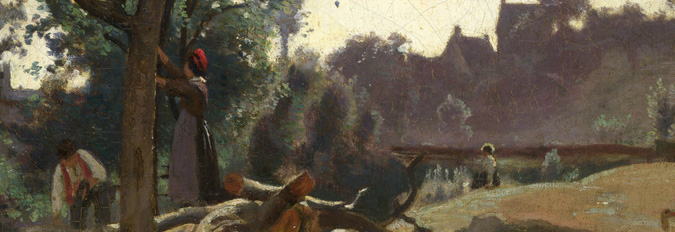Subject
Under a spreading tree in the left foreground a man and a woman stand on and among piles of logs, branches and tree-trunks. The man appears to be sawing and the woman is gathering twigs from the tree itself.5 A stream winds from behind the foreground boulder through the gully on the left-hand side, behind the two figures and to the hill beyond. The young girl in the background is sitting on the bank, looking down at the water. Behind her a wooden bridge links the house on the extreme right with the buildings on the left.
The light is coming from the right background; the little girl and the logs under the tree are all strongly highlighted in shades of cream. The logs also cast strong shadows over the earthy area in front. The hill, directly against the light, appears as misty grey and green, and the houses and trees dissolve in the light.
'Peasants under the Trees at Dawn' depicts a scene in Lormes, the principal town in the area of the Morvan, in western Burgundy. At that period it was known for its rugged terrain and somewhat remote character.6 The inhabitants lived mainly by tree felling, the wood being transported by river, or by keeping cattle.7 The exact site has been identified as being in the mill quarter of the town, a little uphill from the mill seen in Corot’s Cottage and Mill beside a Stream (Morvan or Auvergne) of 1831.8
The tall building just glimpsed on the left is identified as an imposing house, perhaps a former château, which to this day dominates the town’s mill quarter.9 The stream is L’Auxois, which worked all the mills in the town. Both the stream and the mills can be seen in a lithograph by E. Bussière, of around 1825–30. The view in NG 6439 would have been on the left of this lithograph.
Corot’s father’s family originated from this region, specifically from the village of Mussy-la-Fosse, north-east of Semur-en-Auxois. In 1831 Corot made his first visit to the area. Subsequently his niece, Laure Sennegon, married on 16 October 1833 a man from Lormes, Philibert Baudot, and Corot paid them a visit in April 1834 on his way to Italy.10
In the early 1840s Corot visited the area on three occasions. From July to September 1841 he was in Vézelay, Lormes and Saint-André-en-Morvan. In the summer of 1842 he returned to Lormes and Saint-André-en-Morvan, and from September to October 1844 he was again at Saint-André-en-Morvan and at Le Cousin.
There are around 15 paintings of the area dating from this period, described by Kenneth Clark as ‘pictures of a moderate size, firmly constructed, and seen with absolute naturalness, which makes almost every landscape, painted before or since, look slightly artificial’.11 They are distinguished by their originality of composition, including high horizons and closed-in views of dense woodland,12 light effects, and, in this painting in particular, the contre-jour lighting. This exceptional light has led writers to quote Corot’s remark that Claude ‘regardait le soleil en face’.13 Unlike some of the views this painting is undated, and could have been painted on any of these visits.
Copy
The artist William Wyld made a copy of NG 6439, possibly during the period when he owned it (see Provenance).18

